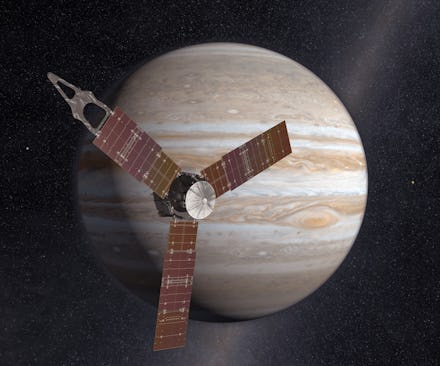NASA's Juno Craft Is Orbiting Jupiter — Here's Why We All Should Be Freaking Out

After five years and about 1.7 billion miles, a solar-powered spacecraft just dodged through dangerous belts of intense radiation and finally arrived at Jupiter. NASA confirmed the Juno spacecraft entered Jupiter's orbit at 11:53 p.m. Eastern on Monday.
The journey itself was an incredible feat, but now Juno is about to reveal huge mysteries about Jupiter and the origin of our solar system.
"Juno is really searching for some hints about our beginnings, how everything started," Juno's principal investigator Scott Bolton said Monday. "But these secrets are pretty well guarded by Jupiter."
Jupiter is the largest planetary body in our solar system, and because of that, it has profoundly shaped the history and evolution of all the other planets in the solar system, including Earth. We know it's the reason there's an asteroid belt between Mars and Jupiter, rather than another planet. We also know that it shields Earth from lots of stray comets from the outer solar system.
But there's a lot we still don't know about it. That's where Juno comes in.
We have a lot to learn about Jupiter
"With Juno, we will investigate the unknowns of Jupiter's massive radiation belts to delve deep into not only the planet's interior, but into how Jupiter was born and how our entire solar system evolved," NASA administrator Charlie Bolden said in a statement.
Juno will investigate Jupiter's atmospheric composition, water content and whether it has a rocky core. Those data points could help scientists figure out how the planet formed and give us some insight into how the rest of our solar system came to be.
"Juno is really searching for some hints about our beginnings, how everything started," Juno's principal investigator Scott Bolton said Monday, according to the New York Times. "But these secrets are pretty well guarded by Jupiter."
We still don't know Jupiter's composition or how the giant swirling storms are connected to the interior of the planet.
Juno will measure the planet's gravitational and magnetic fields and the microwaves it emits, the Times reported. Those measurements could help scientists figure out where Jupiter's "great red spot" and other storm systems on the planet come from.
Juno scientists also expect that they'll discover new moons around Jupiter. The huge gas giant already has 67 known moons — including Europa, where NASA thinks there may be life — but investigators said the Juno mission will probably find more.
The journey to Jupiter
Juno is the first spacecraft to ever come this close to Jupiter, and that comes with a lot of hazards. Jupiter has a magnetic field 14 times stronger than Earth's, and it has a radiation belt that is the equivalent of 100 million X-rays. That would fry the average spacecraft, so Juno's hardware had to be encased in titanium so it can still take pictures and gather data.
Juno will begin its official science collection phase in October, according to NASA, which is when most of the data will start flooding in.
Read more: